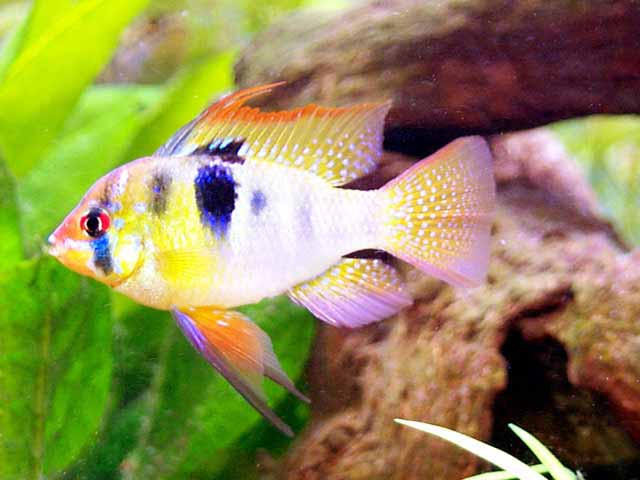Cichlid - Blue Ram
Butterfly Cichlid, Dwarf Ram Scientific Name: Apistogramma ramirezi
Sat, 19th July, 2025 - 2:59 am GMT
Sponsor Ads:

Alternative Name
Butterfly Cichlid, Dwarf Ram Scientific Name: Apistogramma ramireziBasic Info
Because of their bright coloration, Blue Rams are a very desired fish. They will have spots and scales of many colors, including purple, yellow, black, red and blue. Some can even have iridescent spots, which will change colors. Blue rams also have a black vertical stripe. At maturity, Blue Rams will grow to a size of two to three inches, making them just large enough. Blue Rams also have a definitive forked dorsal fin. The male's dorsal fin will be longer than the female's dorsal fin. Females will also tend to be not as bright, but will have a pinkish area on their belly. Blue Rams will usually only live to be three years of age.
Health
Blue Rams can be semi-difficult to care for. They are sensitive to chemicals, temperatures and pH levels. Water temperatures should be kept between 72 and 78 degrees Fahrenheit and pH levels should be slightly acidic, from 6.4 to 7.2. They also need highly oxygenated water, so regular water changes are needed. Due to their chemical sensitivity, good filtered water should be used. Blue Rams like the usual fish foods, including live foods. Bloodworms, glass worms, brine shrimp and tubifex worms, frozen or alive, are great. Freeze dried and flake foods can be given on occasion. Breeding While it can be difficult, it is not impossible to get the Blue Rams to breed. An acid pH is recommended, such as a pH of six. In addition, a warmer water temperature is recommended, at about 80 degrees fahrenheit. When they spawn, Blue Rams will lay approximately 150 to 200 eggs, on a well-cleaned rock. Also, Blue Rams become slightly more territorial and aggressive when breeding, so watch for fights.Habitat
Fresh water fishBehavior
The Blue Ram Cichlid, also known as the Blue Ram, Dwarf Ram, or Butterfly Cichlid, is considered by many to be the more beautiful cichlids. Their bright, dense coloration and small size make them an excellent choice for beginning and experienced aquarists alike. Blue Rams have personalities of their own. Some will be active, some won't be. However, they are overall a peaceful fish and will not bother other fish. Blue Rams might occasionally get into quarrels with each other, but they will never actually physically harm each other. Smaller fish may be eaten however, so be careful. Blue Rams should be kept in medium sized tanks, with plenty of rocks and plants. They should have a few hiding places into which they can retreat from quarrels. Blue Rams will not bother live plants.Origin
South AmericaHistory
The Blue Ram, or Apistogramma ramirezi, can be found in Columbia and Venezuela.Common Foods
N/ASponsor Ads:
"a bad reputation is hard to shake, a good reputation is hard to maintain" -- Anonymous
Cichlid - Blue Ram
Coded by: BGID® | ALL RIGHTS RESERVED Copyright © 2000-2025
Disclaimer | Privacy | Report Errors / Contact | Credits








 Preparing For China. China is growing their military. China Military Technology - can it keep up with the US?
Preparing For China. China is growing their military. China Military Technology - can it keep up with the US?  versus
versus 

 versus
versus 
 This Thread is about the North Korean Military itself - the kind of army, navy, and air force they have.
This Thread is about the North Korean Military itself - the kind of army, navy, and air force they have. 
 versus
versus 
 versus
versus  versus
versus